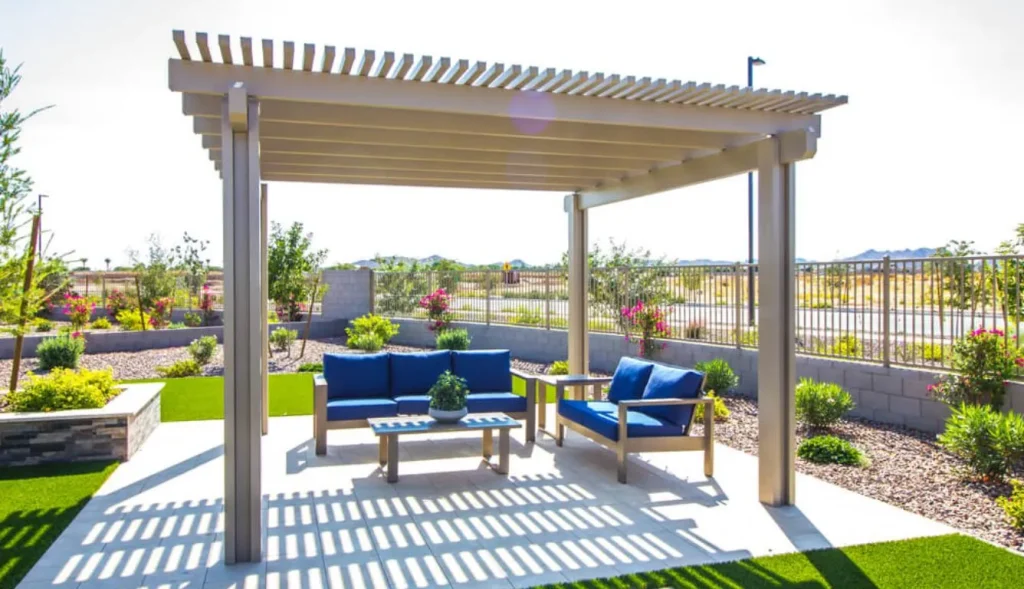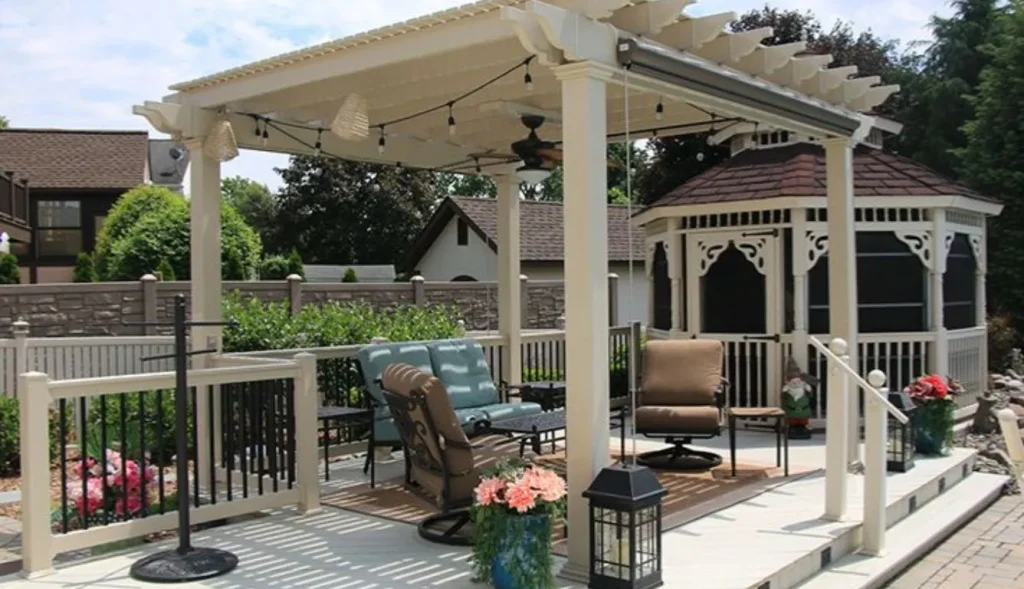Introduction
What is a Pergola?
A pergola is a structure with a framework of vertical posts or pillars that support horizontal crossbeams and an open lattice. It’s often used to create a shaded walkway, passageway, or seating area in gardens and yards. Unlike a full roof, the lattice allows sunlight to filter through, making it a perfect addition for outdoor spaces that need both structure and light.

Brief History of Pergolas
Pergolas have been around for centuries. Originally used in ancient Rome and Greece, they were designed to provide shade and shelter in garden spaces. Over time, the design has evolved, but the core idea of creating a defined outdoor space remains unchanged.
The Benefits of Adding a Pergola
Creating a Defined Outdoor Space
One of the primary benefits of a pergola is its ability to define outdoor areas. Whether you’re looking to create a cozy nook for reading or an elegant space for dining, a pergola helps delineate the space from the rest of your yard. It’s like adding a room to your home, but outside!
Enhancing Aesthetic Appeal
Pergolas come in various styles and materials, making them a versatile addition to any garden. They can be designed to complement your home’s architecture or add a touch of charm to a more rustic garden. By incorporating elements like climbing plants or decorative finishes, you can enhance the visual appeal of your outdoor space.
Providing Shade and Comfort
Pergolas offer a degree of shade, making outdoor areas more comfortable during hot weather. While they don’t provide complete coverage like a solid roof, they can be outfitted with fabric or retractable canopies for additional protection. This makes them ideal for creating a relaxing spot to escape the sun.
Increasing Property Value
A well-designed pergola can increase your property’s value by enhancing its appeal and functionality. Prospective buyers often appreciate the added charm and utility of a pergola, making it a worthwhile investment if you’re considering selling your home in the future.
Offering Versatility in Design
Pergolas are incredibly versatile. They can be adapted to fit any style, from classic and traditional to modern and sleek. This flexibility allows you to create a structure that fits your specific needs and aesthetic preferences, making it a valuable addition to any outdoor space.
Different Types of Pergolas
Traditional Pergolas
Traditional pergolas feature classic designs with a simple, open framework. They are often made of wood and are ideal for creating timeless, elegant outdoor spaces. Their straightforward design makes them easy to customize with various decorative elements.
Modern Pergolas
Modern pergolas incorporate sleek lines and contemporary materials. They often use metals like aluminum or steel, and their clean, minimalistic design fits well with modern homes. These pergolas can include innovative features like retractable roofs or integrated lighting.
Retractable Pergolas
Retractable pergolas offer flexibility with a roof that can be extended or retracted based on the weather. This allows you to enjoy both sunny days and rainy afternoons under the same structure. They’re perfect for those who want a versatile solution for their outdoor space.
Arched Pergolas
Arched pergolas feature a curved design, adding a touch of elegance and sophistication. The arch can serve as a focal point in your garden, creating a beautiful passageway or entrance. They are often adorned with climbing plants to enhance their visual appeal.
Freestanding vs. Attached Pergolas
Freestanding pergolas are independent structures that can be placed anywhere in your yard, while attached pergolas are connected to your home. Both have their advantages: freestanding pergolas offer flexibility in placement, while attached pergolas can seamlessly blend with your home’s existing design.
Materials Used for Pergolas
Wood
Wood is a traditional and popular choice for pergolas due to its natural beauty and versatility. Options like cedar, pine, and redwood are commonly used. Wood can be stained or painted to match your home’s exterior, and it’s relatively easy to work with for DIY projects.
Metal
Metal pergolas, made from materials like aluminum or steel, offer durability and a modern look. They require less maintenance than wood and can be powder-coated to prevent rust. Metal pergolas are ideal for contemporary designs and can withstand various weather conditions.
Vinyl
Vinyl pergolas provide a low-maintenance alternative to wood and metal. They are resistant to rot, insects, and weathering. Vinyl pergolas are available in various colors and styles, making them a versatile option for many outdoor settings.
Combination Materials
Some pergolas use a combination of materials to achieve the desired look and functionality. For example, a wooden pergola with metal accents or a vinyl pergola with wooden beams can create a unique and customized appearance.
How to Choose the Right Pergola for Your Space
Size and Scale Considerations
When choosing a pergola, consider the size of your outdoor space and how the pergola will fit within it. Measure the area where you plan to install the pergola and ensure it complements the scale of your yard and home. A well-proportioned pergola will enhance the overall look of your outdoor area.
Style Matching
Select a pergola style that matches your home’s architecture and your personal taste. Whether you prefer a traditional wooden pergola or a sleek metal design, make sure it harmonizes with the existing elements of your garden or patio.
Budgeting for Your Pergola
Pergola costs can vary significantly depending on materials, size, and design complexity. Set a budget before starting your project and consider both the initial cost and long-term maintenance expenses. This will help you choose a pergola that fits your financial plans.
Maintenance and Durability
Different materials require different levels of maintenance. Wood needs regular staining or sealing, while metal and vinyl are generally low-maintenance. Consider how much time and effort you’re willing to invest in maintaining your pergola when choosing the material.
Pergola Installation Tips
Preparing Your Site
Before installing a pergola, prepare your site by clearing any debris and ensuring the ground is level. Proper site preparation will make the installation process smoother and help ensure the longevity of your pergola.
DIY vs. Professional Installation
Decide whether you want to tackle the installation yourself or hire a professional. DIY installation can be cost-effective but requires a certain level of skill and tools. Professional installation ensures the job is done correctly and can save time and potential headaches.
Ensuring Proper Foundations
A solid foundation is crucial for the stability of your pergola. Depending on the size and material, you may need concrete footings or anchors to secure the posts. Proper foundation work will prevent issues like leaning or instability over time.
Adding Personal Touches
Once your pergola is installed, add personal touches to make it your own. Consider incorporating elements like climbing plants, hanging lights, or comfortable furniture to enhance the functionality and aesthetic appeal of your pergola.
Uses for Pergolas
Outdoor Dining Areas
Pergolas can create a stylish and functional dining area in your garden or patio. Add a dining table and chairs under your pergola to enjoy meals outdoors, protected from the sun or light rain.
Garden Walkways
Use a pergola to frame a garden walkway, creating an elegant passage through your garden. Add climbing plants or vines for a lush, green effect that enhances the beauty of your outdoor space.
Relaxation Zones
Transform a corner of your garden into a relaxation zone with a pergola. Add comfortable seating, cushions, and perhaps a hammock or swing for a cozy spot to unwind and enjoy the outdoors.
Event Spaces
Pergolas are perfect for hosting outdoor events such as parties or weddings. Their open design allows for easy decoration and can create a charming venue for gatherings with friends and family.
Decorating Your Pergola
Lighting Options
Illuminate your pergola with various lighting options like string lights, lanterns, or pendant lights. Lighting not only adds ambiance but also extends the usability of your outdoor space into the evening.
Plants and Vines
Enhance the look of your pergola with climbing plants and vines. Options like wisteria, clematis, or grapevines can provide natural shade and a lush, green backdrop, adding to the visual appeal.
Furniture and Accessories
Furnish your pergola with comfortable furniture, such as outdoor sofas, tables, or chairs. Accessories like rugs, cushions, and throws can make the space more inviting and cozy.
Maintaining Your Pergola
Cleaning and Upkeep
Regular cleaning is essential to keep your pergola looking its best. Remove debris, check for any signs of damage, and clean surfaces as needed. Maintenance will ensure your pergola remains a beautiful and functional part of your outdoor space.
Seasonal Preparations
Prepare your pergola for different seasons by addressing issues like rust, rot, or wear. For example, in winter, you may need to clear snow or ice to prevent damage, while in summer, ensure proper ventilation and check for plant overgrowth.
Repair and Restoration
Address any repairs promptly to maintain the integrity of your pergola. Whether it’s fixing loose beams, repainting, or replacing damaged sections, timely maintenance will help extend the life of your pergola.
FAQs
What is the best material for a pergola?
The best material depends on your preferences and needs. Wood is traditional and versatile, metal offers modern durability, and vinyl provides low maintenance. Consider factors like style, maintenance, and climate when choosing.
How much does it cost to build a pergola?
Costs vary based on size, materials, and design complexity. A basic wooden pergola might cost a few hundred dollars, while more elaborate metal or custom designs can run into the thousands. Always get multiple quotes and plan your budget accordingly.
Can a pergola be used year-round?
While pergolas provide partial shelter, they are not typically designed for year-round use. Adding features like retractable canopies or side curtains can make them more versatile in different weather conditions.
Do pergolas require a lot of maintenance?
Maintenance depends on the material. Wood requires regular staining or sealing, while metal and vinyl are generally low-maintenance. Regular cleaning and seasonal checks will help keep your pergola in good condition.
How can I make my pergola more private?
To enhance privacy, consider adding curtains, bamboo screens, or climbing plants. These options can provide a more secluded space and add to the overall aesthetics of your pergola.

Conclusion
A pergola can be a valuable addition to your outdoor space, offering benefits like creating defined areas, enhancing aesthetics, and providing comfort. With various styles, materials, and uses, there’s a pergola design to fit every need and taste. By choosing the right pergola and properly maintaining it, you can enjoy a stylish and functional outdoor space for years to come.


Congratulation!